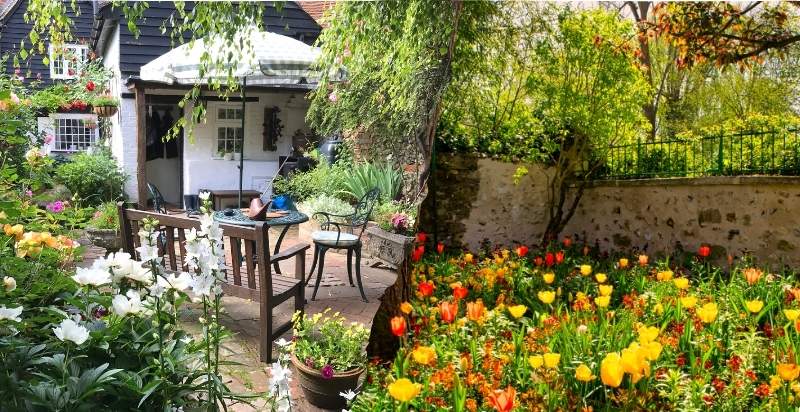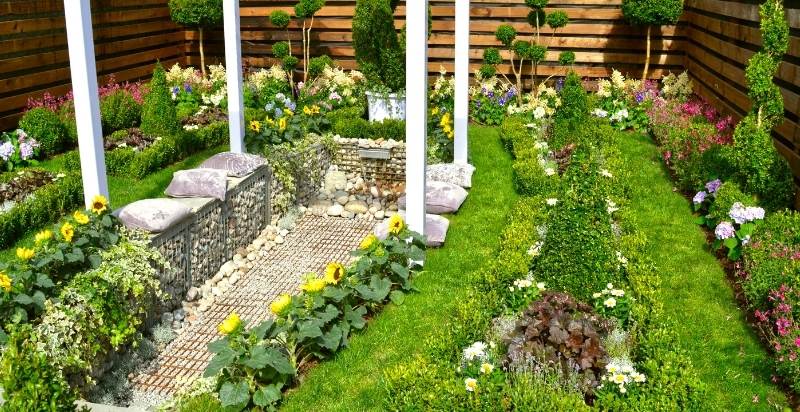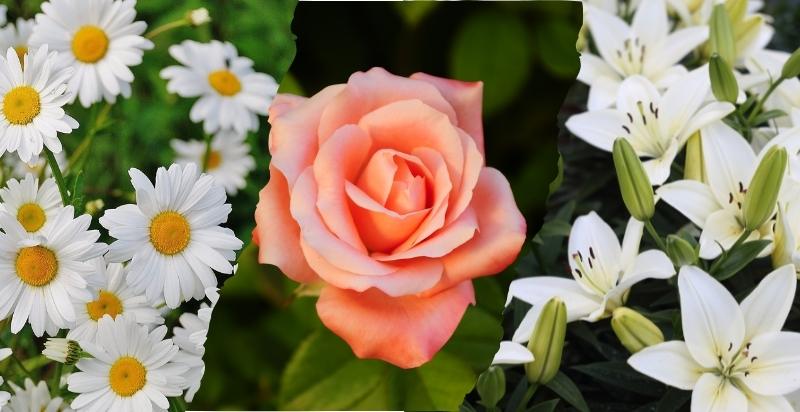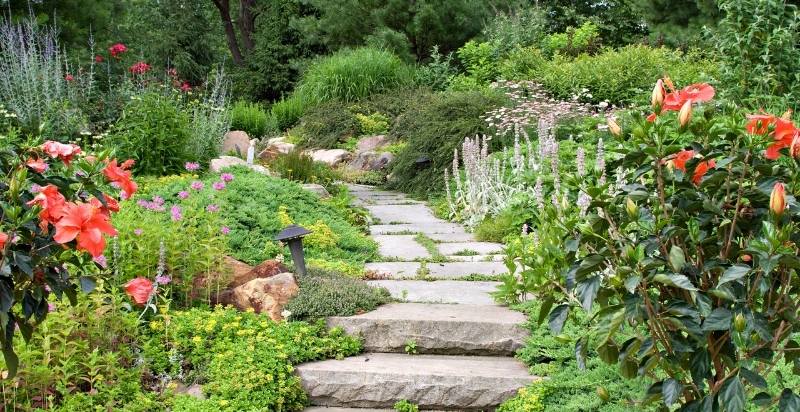A cottage garden is a type of garden that is typically found in rural, English-speaking countries. These gardens are usually situated near a house or other small building, such as a cottage.
The word “cottage” can also be used to refer to the type of house in which these gardens are found. In England, the term “cottage garden” often conjures up images of a quaint, bucolic scene, with a small Thatched roof cottage surrounded by a profusion of colorful flowers.
While the classic English cottage garden may be what first comes to mind when thinking about this type of gardening, there are actually many different styles of cottage gardens. Below we will explore some of the most popular types of cottage gardens:
Styles of Cottage Gardens:
As we mentioned above, there is no one specific style of cottage garden. However, there are a few different styles that are most commonly seen. These include:
- The English Cottage Garden: This is the style of cottage garden that is probably most familiar to people. It is characterized by a relaxed, informal layout with an abundance of flowers. English cottage gardens often make use of “old-fashioned” or heirloom plants, such as roses, hollyhocks, and lavender.
- The French Cottage Garden: French cottage gardens tend to be more formal than their English counterparts. They often feature straight paths and symmetrical plantings. Like English cottage gardens, French cottage gardens are usually filled with a variety of flowers.
- The American Cottage Garden: American cottage gardens often have a more “wild” look to them, making use of native plants and naturalized plantings. They may also incorporate some vegetables into the mix.

What Are The Key Features Of A Cottage Garden?
A cottage garden is a type of garden that is typically found in rural areas. It is characterized by its informal design, which includes a mix of flowers, vegetables, and herbs. Cottage gardens are often designed to be low maintenance, so that they can be enjoyed without a lot of work.
Some key features of cottage gardens include:
- Informal Design: As mentioned, one of the key features of cottage gardens is their informal design. This means that there is no strict layout or plan to follow – instead, plants are simply added in as they are wanted or needed. This results in a relaxed and natural look.
- Mix of Flowers, Vegetables, and Herbs: Another key feature of cottage gardens is the mix of flowers, vegetables, and herbs that are typically found in them. This mix allows for a colorful and diverse garden that can provide both beauty and utility.
- Low Maintenance: As mentioned, cottage gardens are often designed to be low maintenance. This means that they do not require a lot of time or effort to keep them looking nice. This is ideal for busy people who still want to enjoy a beautiful garden.
What Are The Benefits Of Growing A Cottage Garden?
There are many benefits of growing a cottage garden such as :
1. Fresh Produce
One of the biggest benefits of growing a cottage garden is the ability to grow your own fresh produce. With a little planning and effort, you can grow a wide variety of fruits and vegetables that will be perfect for eating right off the vine or using in recipes. Not only is homegrown produce tastier than store-bought, but it’s also more nutritious. And, when you grow your own food, you’ll know exactly what has been used to fertilize and pesticide it.
2. Attracting Wildlife
Another benefit of cottage gardens is that they can attract a variety of wildlife. By planting native flowers, shrubs, and trees, you can provide food and shelter for birds, bees, butterflies, and other animals. In turn, these animals will help pollinate your plants and control pests. Creating a habitat for wildlife is a great way to give back to the environment.
3. Beauty
In addition to being functional, cottage gardens are also incredibly beautiful. When planning your garden, be sure to choose a variety of flowers in different colors and shapes. You should also consider adding some ornamental elements like bird baths, trellises, or statues. With a little bit of creativity, you can create an outdoor space that is both lovely and inviting.
4. Reducing Your Carbon Footprint
When you grow a cottage garden, you’ll also be doing your part to reduce your carbon footprint. Transporting food from farms to grocery stores requires a lot of energy and resources. By growing your own food, you can reduce the amount of pollution that is caused by the agricultural industry. In addition, growing your own food will also save you money on groceries.
5. Supporting Local Businesses
Finally, growing a cottage garden is a great way to support local businesses. When you purchase seeds or plants from a local nursery, you’ll be helping to boost the economy in your community. In addition, you’ll have the opportunity to meet other gardeners and learn about new plants.
As you can see, there are many benefits of growing a cottage garden. From fresh produce to attracting wildlife, cottage gardens offer something for everyone. So, what are you waiting for? Start planning your garden today!

How Do You Design a Cottage Garden that’s Perfect For Your Home and Lifestyle?
Cottage gardens are charming, romantic and often fragrant. They can be packed with perennials, annuals, bulbs and even vegetables, herbs and fruit. But how do you design a cottage garden that will work for your home and lifestyle?
Here are some tips:
1. Consider The Size Of Your Yard:
A cottage garden can be as small as a few feet square or as large as an acre or more. If you have a small yard, consider using containers to increase the planting area. If you have a large yard, you may want to create several distinct garden areas within the overall space.
2. Think About How Much Sun Or Shade Your Yard Gets:
Cottage gardens need at least six hours of sunlight a day, but they can tolerate some shade. If your yard gets less than six hours of sun, you may want to consider planting more shade-tolerant plants.
3. Consider Your Soil Type:
Cottage gardens do best in well-drained, fertile soils. If your soil is heavy or clay-based, you may want to consider raised beds or other methods of improving drainage.
4. Decide What Kind Of Plants You Want To Grow:
Do you want mostly flowers? Or are you interested in growing vegetables, herbs or fruit? Once you know what kinds of plants you want to grow, you can start planning your garden layout.
One of the most important aspects of designing a cottage garden is choosing the right plants. When selecting plants for your garden, it’s important to consider their growth habit, flowering time, and color. You’ll also want to make sure that they’re suitable for your climate zone.
If you’re not sure which plants are right for your garden, ask a local nursery or gardening center for help. They can offer advice on which plants will do well in your particular climate.
5. Consider The Elements Of Design:
Cottage gardens are often informal, with a relaxed layout. But there are still some basic design principles you’ll need to consider, such as unity, balance and proportion.
Once you’ve selected the plants for your cottage garden, it’s time to start designing it. When planning your garden, consider how you’ll use it. Do you want a place to grow vegetables? Or, do you want a space for entertaining guests?
Think about where you’ll put pathways, seating areas, and other features. It’s also important to consider the amount of sun and shade that each area of your garden will get. This will help you choose plants that will thrive in those conditions.
Creating a cottage garden that’s perfect for you takes time and effort. But, the results are worth it. With a little planning, you can create a beautiful garden that you’ll enjoy for years to come.
Additional Information:
When designing your cottage garden, consider adding some of these features:
- Pergola: A pergola is a structure that supports climbing plants. It’s a great way to add height and interest to your garden.
- Arbor: An arbor is similar to a pergola, but it has a solid roof. It’s a perfect place to hang lanterns or fairy lights.
- Garden Bench: A bench is a great way to create an inviting space in your garden. Place it in a sunny spot and add some cushions for extra comfort.
- Pond: A pond adds beauty and relaxation to any garden. It’s also a great place to attract wildlife, such as birds and butterflies.
- Windmill: A windmill is a charming addition to any cottage garden. It can be used to decorate your garden or to generate power for your home.
- Solar Lights: Solar lights are a beautiful way to light up your garden at night. They’re also environmentally friendly and easy to install.
- Fountain: A fountain is a classic cottage garden feature. It adds the sound of flowing water to your garden and creates a relaxing atmosphere.
- Garden Shed: A garden shed is a great place to store garden tools, potting soil, and other supplies. It’s also a cozy spot to take a break from gardening. No matter what features you choose, remember that the key to creating a perfect cottage garden is to have fun and be creative!
6. Think About How You’ll Use The Garden:
Do you want a place to relax and enjoy the flowers? Or do you want a more functional space for entertaining or growing your own food? Knowing how you’ll use the garden will help you determine the layout and plant selection.
7. Don’t Forget The Details:
Cottage gardens are all about the little things that make them special. Consider adding a birdbath, trellis or other garden features to personalize your space.
8. Start small and expand as needed:
You don’t need to have everything perfect from the start. Start with a small section of the garden and add to it as you have time and resources.
By following these tips, you can design a cottage garden that’s perfect for your home and lifestyle.
What Plants And Flowers Work Well In A Cottage Garden ?
There is no definitive answer to this question, as different gardeners have different preferences for what they consider to be a “perfect” cottage garden. However, there are certain plants and flowers that are commonly found in cottage gardens, and these tend to be chosen for their ability to create a relaxed and informal atmosphere.
Some of the most popular cottage garden plants include roses, lavender, daisies, and lilies. These flowers are all known for their pretty blooms and sweet scents, which can help to create a lovely ambiance in any garden. Other popular choices include herbs such as mint and thyme, which can add a touch of flavor to your garden, as well as vegetables such as tomatoes and cucumbers, which can be used to add a splash of color.
When it comes to choosing the perfect plants and flowers for your cottage garden, it is important to consider what kind of look you are trying to achieve. If you want a more traditional cottage garden feel, then focus on choosing plants that are typically associated with this style, such as roses and lavender. However, if you are looking for something a little different, then don’t be afraid to experiment with different plant choices until you find the right combination for your garden.

What Are Some Common Problems That Occur with Cottage Gardens?
There are many common problems that can occur with cottage gardens, but fortunately, most of these problems can be remedied quickly and easily. Here are some of the most common cottage garden problems and how to fix them:
Weeds
Weeds are one of the most common problems in cottage gardens. They can quickly take over your garden and crowd out your flowers and other plants. The best way to deal with weeds is to prevent them from getting established in the first place. Pull them up as soon as you see them and keep the area around your garden free of debris where they can seed themselves. Mulching your garden with organic material like bark chips or straw will also help to prevent weed growth.
Pests
Pests can be a big problem in cottage gardens, especially if you are growing fruits and vegetables. Aphids, caterpillars, and slugs are just a few of the pests that can wreak havoc on your plants. The best way to deal with pests is to keep an eye out for them and take action as soon as you see them. Hand-picking pests off of your plants is often the best method, but you can also use organic pesticides if necessary.
Diseases
Diseases can also be a problem in cottage gardens, especially if you are growing delicate plants. Powdery mildew, black spot, and rust are all common diseases that can affect your plants. The best way to deal with diseases is to prevent them from getting established in the first place. Keep your garden clean and free of debris where diseases can spread. Water your plants early in the day so that the leaves have time to dry before nightfall. And, if you see any signs of disease on your plants, immediately remove the affected leaves and dispose of them.
With a little bit of care and attention, you can easily avoid or fix most common problems that occur in cottage gardens. By following these tips, you can keep your garden healthy and beautiful for years to come.
How To Care For Your Cottage Garden Throughout The Year ?
Cottage gardens are lovely, but they can be a lot of work. This guide will help you keep your cottage garden looking its best throughout the year.
- January: Start planning your cottage garden. Decide what flowers and plants you want to grow, and where you want to put them. Draw a map of your garden, or create a digital one using a program like Garden Planner.
- February: Order your seeds and start from a reputable source. Make sure to get plants that are well-suited for your growing zone and sunlight exposure.
- March: Begin preparing your garden beds. Amend the soil with compost or other organic matter, and till it to a depth of about 8 inches. If you plan on using raised beds, build them now.
- April: Plant your seeds and start according to your plan. Water regularly, and fertilize as needed.
- May: Continue to water and fertilize as needed. Many cottage garden plants will begin to bloom this month, so enjoy the colorful display!
- June: Deadhead spent flowers regularly to encourage more blooming. Pull up any weeds that have popped up.
- July: This is a good month to divide and transplant overcrowded perennials. Water regularly, especially if there has been little rain.
- August: Keep an eye out for pests and diseases, and take action accordingly. Deadhead flowers as needed.
- September: Start collecting seeds from your favorite plants. This is also a good time to divide and transplant any perennials that need it.
- October: Prepare your garden beds for winter by adding a layer of mulch. This will help protect the roots of your plants from the cold.
- November: If you live in an area with freezing winters, cover delicate plants with a layer of burlap or straw.
- December: Enjoy your cottage garden! Take this time to plan next year’s garden, and order any seeds or starts you’ll need.
Ideas And Inspiration For Creating Your Own Cottage Garden:
There’s something so charming and inviting about a cottage garden. Perhaps it’s the lived-in look, or the sense that these gardens are a labor of love. Whatever the reason, they’re always appealing.
If you’re thinking about creating your own cottage garden, here are some ideas and inspiration to get you started.
- Think about scale. A cottage garden should feel cozy, so keep that in mind when choosing plants. Think about adding a mix of small shrubs, perennials, and annuals to create a layered look.
- Choose plants that will attract bees and butterflies. Cottage gardens are all about encouraging wildlife, so include flowers that will do just that. Lavender, foxgloves, and cosmos are all good choices.
- Include some edibles. Cottage gardens were traditionally planted with a mix of flowers and vegetables, so don’t be afraid to add in some fruits and veggies. Strawberries, raspberries, and herbs are all great options.
- Create a path. Meandering paths are key to creating that cottage garden feel. Use stone pavers, bricks, or gravel to create a path that leads through your garden.
- Add some furniture. A few well-placed pieces of garden furniture will make your cottage garden even more inviting. A bench near the edge of the garden is the perfect spot for enjoying a cup of tea or glass of lemonade on a summer day.
These are just a few ideas to get you started. Have fun and be creative as you design your own cottage garden.
1. Go for a natural look
The best cottage gardens have a relaxed, natural look. To achieve this, choose plants that are native to your area or that have a wild, untamed appearance. Avoid perfectly manicured flowers and instead go for blooms that look like they’ve just been plucked from the meadow.
2. Create a sense of enclosure
To really make your cottage garden feel like its own little oasis, create a sense of enclosure with hedges, fences or walls. This will not only give the space a cozier feeling but will also help to protect your plants from strong winds and other harsh weather conditions.
3. Use colorful flowers
One of the trademarks of a cottage garden is its abundance of color. To get this look, choose flowers in a variety of shades and plant them close together so that they appear to be spilling out from one another.
4. Incorporate Different Textures
To add interest and visual appeal to your cottage garden, incorporate different textures into the design. Use plants with differently shaped leaves, such as hostas or ferns, to create contrast. You can also add texture by using stone or gravel in your mulch or planting beds.
5. Don’t Forget The Herbs
Herbs are an essential part of any cottage garden. Not only do they add flavor to your cooking, but they also help to attract bees and other beneficial insects. Include a variety of herbs in your garden, such as basil, oregano, thyme and mint.
6. Add Some Whimsy
To really give your cottage garden personality, add some whimsical elements like sculptures, birdhouses or wind chimes. These touches will make the space feel more like yours and will help to create a truly unique outdoor oasis.

Are there any Common Mistakes People make with their cottage gardens, and how can you avoid them yourself?
One of the most common mistakes people make when planning their cottage garden is failing to take into account the size and scale of their plants. Make sure you know how big your plants will grow before you start planting, so you can space them out accordingly. Another mistake is not considering the needs of your plants when it comes to sunlight and water. Be sure to research the sun and water requirements of each plant before adding it to your garden. Finally, don’t forget to add some seasonal interest to your cottage garden by including a few bulbs or annuals that will bloom at different times throughout the year. By following these simple tips, you can create a beautiful and inviting cottage garden that will be the envy of your neighbors.
- Everything you wanted to know about Green Tiger Tomatoes. - April 1, 2024
- Everything you wanted to know about Atomic Grape Tomatoes . - April 1, 2024
- Plum Types and Varieties: A Comprehensive Overview | GardenersMag . - April 1, 2024

1 thought on “Cottage Garden: The Ultimate Guide ”